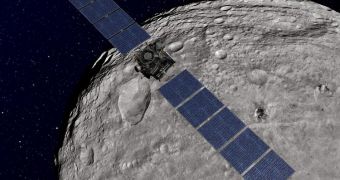Mission controllers at the NASA Jet Propulsion Laboratory (JPL), in Pasadena, California, have just received official confirmation that they can maintain the Dawn spacecraft in orbit around the protoplanet Vesta for 40 days beyond the initial scheduled departure time.
The orbiter arrived at the largest asteroid in our solar system in mid-July 2011, for a 1-year mission. Original plans called for it to exist Vesta's orbit around July 15, 2012, and to start heading for the dwarf planet Ceres immediately afterwards.
Scientists analyzed the possibility of spending some extra time at Vesta thoroughly. The goal was to gather as much science as possible, without jeopardizing the planned, February 2015 arrival data at Ceres. The 40-day extension meets both objectives.
Dawn now has permission to continue studying its current target until August 26. Both Vesta and Ceres are located in the solar system's Inner Asteroid Belt (IAB), between the orbits of Mars and Jupiter.
Due to careful management of mission funds, the extension will not require the JPL team to search for additional cash. Financial reserves from earlier in the mission are available to fund the prolonged stay.
The spacecraft will remain in its current low-altitude mapping orbit (LAMO) until May 1. Dawn is now flying around 210 kilometers (130 miles) above the surface of the asteroid. During the extension, the probe will use its gamma ray and neutron detectors first and foremost.
These instruments will enable scientists to create detailed maps of Vesta's surface and its elemental composition, as well as improve existing gravity maps for the massive object. Additional high-resolution images of the surface will be collected using onboard cameras and spectrometers.
“We are leveraging our smooth and successful operations at Vesta to provide for even more scientific discoveries for NASA and the world,” JPL Dawn project manager, Robert Mase, explains.
“This extra time will allow us to extend our scientific investigation and learn more about this mysterious world,” he goes on to say.
Christopher Russell, an University of California in Los Angeles (UCLA) professor who is the principal investigator of the mission, says that “Dawn has beamed back to us such dazzling Vestan vistas that we are happy to stay a little longer and learn more about this special world.”
“While we have this one-of-a-kind opportunity to orbit Vesta, we want to make the best and most complete datasets that we can,” Russell concludes.

 14 DAY TRIAL //
14 DAY TRIAL //